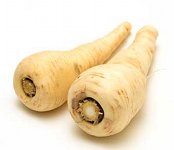|
|
|
|
|
Nutrition:
As
in
carrots
and other members of apiaceae family vegetables,
parsnip too contains many poly-acetylene anti-oxidants
such as falcarinol, falcarindiol, panaxydiol, and
methyl-falcarindiol. In addition, it also has healthy
levels of minerals like iron, calcium, copper,
potassium, manganese and phosphorus. Potassium is an
important component of cell and body fluids that helps
controlling heart rate and blood pressure by
countering effects of sodium.
Taste:
Its
fleshy,
stout roots appear like that of carrots, but are white
or cream in color and sweeter than that of carrots.
Uses:
To
prepare,
wash them in cold water and scrub or gently peel the
skin. Trim off the ends. Cut into cubes, disc, and
pieces as you desire and cook as you would carrots.
Substitutions:
Carrots
are
probably the closest substitute.
Storage:
Store
parsnips in a plastic bag and place in the vegetable
drawer of the refrigerator.
|
![]()
|
|
Copyright
©
2011 www.evergoodfarm.com
Rhinelander,
WI
54501, USA
All
Rights
Reserved
|





